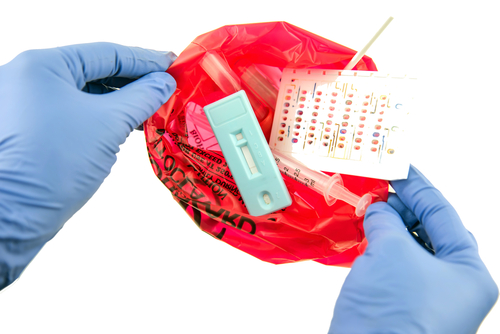
Biohazard waste, if handled or disposed of incorrectly, poses a serious threat to human health and well-being. It can cause the spread of many different types of pathogens, including the novel coronavirus that causes COVID-19.
Thus, it’s critically important that any employee who handles biohazard waste is properly equipped and trained to deal with it. In this article, we’ll help you understand what biohazard waste is, the potential safety hazards that it creates and what your responsibilities are when disposing of it.
What Is Biohazard Waste?
Biohazard waste is waste from medical and scientific facilities that poses a risk of pathogen contamination to humans, animals or the environment. It can generally be broken into the following categories:
- Animal Products: The carcass, body parts or excretory waste of any animal that is infectious, potentially infectious or genetically modified. Common in research laboratories.
- Solid Lab Waste: Miscellaneous dry trash from laboratories, such as petri dishes, plastic pipettes, euthanized invertebrates, plastic gloves and contaminated animal bedding. Also known as “dry” biohazard waste.
- Human Anatomical/Pathological Specimens: Samples of human tissue or bodily fluids that may contain pathogens.
- Liquids: Liquid cultures or specimens that contain or may contain biohazardous pathogens.
- Sharps: Sharp objects, such as needles, scalpels and broken glass. These objects are especially hazardous because they can instantly introduce pathogens under the skin through incidental contact.
Order Your Biohazard Kit Today!
The federal government doesn’t provide a single, uniform definition of biohazard waste. Rather, each state has different regulations for classifying regulated medical waste (RMW). The first step to safe biohazard waste disposal is to check with your state’s Department of Health to learn the specific regulations you’ll need to follow.

Biohazard Waste Disposal Procedures
The standard procedure for biohazard waste disposal varies by type of biohazard waste and by state law. However, there are some common steps that most biohazard disposal procedures will involve:
- Apply any necessary medical PPE, including nitrile gloves and/or face mask.
- Place the biohazard waste in a designated biohazard container. Specific biohazard container designs will vary by application and state. In most states, you’ll use a thick plastic biohazard bag, colored red or yellow, with the biohazard symbol markings. (What goes in a biohazard bag varies according to state law and substance type.) For sharps, you’ll use a rigid plastic box with a plastic liner and biohazard symbol markings.
- Apply any required labels, such as a U.N. Hazard Class 6 label, to the biohazard waste container. Other required labels may include contact information for the waste’s facility of origin.
- Place the packaged waste at dedicated waste accumulation sites where you can deposit packaged biohazard waste. This site should be secure and have regularly scheduled pickups from a licensed biohazard disposal company. Make sure to note your facility’s maximum storage time for biohazard waste, as many require waste disposal within a certain time limit.
- Your licensed medical waste disposal company will collect the biohazard waste and transport it to its waste disposal facility for sterilization and/or incineration. Contact medical waste disposal companies in your area to learn which types of waste they can process.
The Centers for Disease Control recommends that certain types of microbiologic wastes, such as high-concentration cultures of infectious substances, be treated on-site. Steam sterilization using a laboratory autoclave is the preferred method, although some facilities also use on-site incinerators. If your facility works with federally designated “select agents” that pose a severe public health risk, on-site sterilization using specific methods may be required.
Properly Label Biohazard Waste with Hazmat Stickers
Biohazard Shipping Products from Air Sea Containers
Air Sea Containers offers a variety of biohazard shipping solutions for medical and laboratory facilities. We have the following options available:
- Biohazard Pouches: Thick and durable laminated LDPE pouches with an exclusive Bio-Zip sealing technology for more security and easier access.
- Bio-Bottles: HDPE pressure vessels suitable as secondary containers for U.N. Class A and Class B infectious substance packaging.
- Biohazard Shipping Kits: All-in-one kits designed as U.N.-compliant packaging solutions for Class A and Class B infectious substances. These kits include a Bio-Bottle, U.N. hazmat box and refreezable phase change packs to keep specimens at a suitable temperature.
- Hazmat Boxes: We offer a wide range of corrugated shipping boxes constructed to U.N. hazmat standards for the transportation of hazardous materials.

Air Sea Containers Biohazard Pouch, Specimen Bag: 9.5″ x 6.5″
Need in-depth advice on biohazard waste packaging for safe disposal? Ask the experts—call Air Sea Containers at (866) 596-9448 or contact us online.




